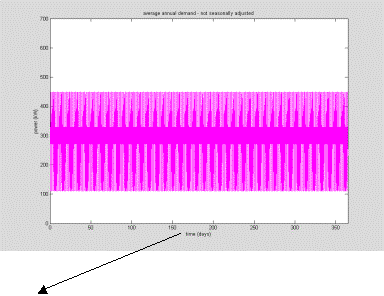varying with ambient temperatures. Other electricity usages were considered to
be seasonally invarient.
Determining annual variation of daylight times
we get the following graph.

Estimating annual temperature variation, from
Met. Office statistics we get.

By inverting these variations, and scaling
to an average of one, the following lighting and heating indexes were formed.


By apportioning 40% of the lighting index,
30% of the heating index and 30% of a unity index to the daily average annual
consumption profile, the prediction annual demand profile for the case study
was calculated, as shown in the following figure.
x



The above figure shows the demand
profile prediction for the secondary distribution network of our case-study
during a typical year . (The elaboration of the data and the formation
of the graphs were made in Matlab software).